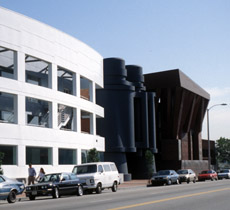index
Mixed places
click on images for full-size:

The Chiat-Day office in Venice, California, designed by Frank Gehry

Wired Magazine's 1994 description of the ambitious Chiat-Day experiment with a mixed virtual/physical office

Wired Magazine's 1999 description of the failure of the Chiat-Day experiment
Because our places no longer always circle around any real or symbolic centers, contemporary places may discontinuous in ways that classic places would refuse. One kind of discontinuity is to mix physical and virtual spaces.
Guillermo Vasquez de Valasco and David Hutchinson of Texas A&M's College of Architecture presented the Infinity Room, an experiment in collaborative design between remote participants. The Infinity Room allows Texas students to communicate live with colleagues in Mexico using a network of video cameras, projectors, and screens. Whereas conventional videoconferencing shows only the correspondents' heads, the Infinity Room projects full body images. Texas students "see" their Mexican counterparts as if they were actually in Texas, and vice versa. Since the viewers are present in each other's space, both parties perceive an overlap of spaces. This produces a hybrid of physical space and cyberspace -- or cybrid -- where both parties coexist. Anders 2000, 49
The mixture can be mobile as well. Some years ago, the advertising agency Chiat-Day reconfigured its offices to eliminate permanent stations for employees, and developed a computer network that offered virtual places where employees could meet and talk. Employees met both in physical rooms and in the conferencing software's virtual place, which included manipulable icon pictures for each employee. Conferences, deliberations, and decisions happened across that mixture of real and virtual spaces, in which neither component was spatially continuous. During the time that arrangement was in effect, the Chiat-Day office was a place that was composed of a number of discontinuous physical and virtual areas. (The experiment did not work out well, because of employee resistances and because it was too ambitious for the available technology, but what was created was still a new kind of place.)
The trend to non-owned office spaces is accelerating. "At Arthur Anderson's new Baltimore office, for example, fully 170 out of 204 employees go without any permanently assigned space. Instead, they reserve space each morning at a computer kiosk" (Chadderdon 1999, 93-94). A further step is the wireless "field of presence" for mobile workers not tied down to a given kiosk or any particular location. (For a discussion, see Mitchell 2003.) However, the computer connections opened in these situations resemble bulletin boards more than places, so these arrangements do not create the discontinuous spaces of the Chiat-Day experiment.
- [Return to "places today outline"]
- [Nearby: Discontinuous places -- Virtual/physical places -- Evaluating discontinuous places ]


